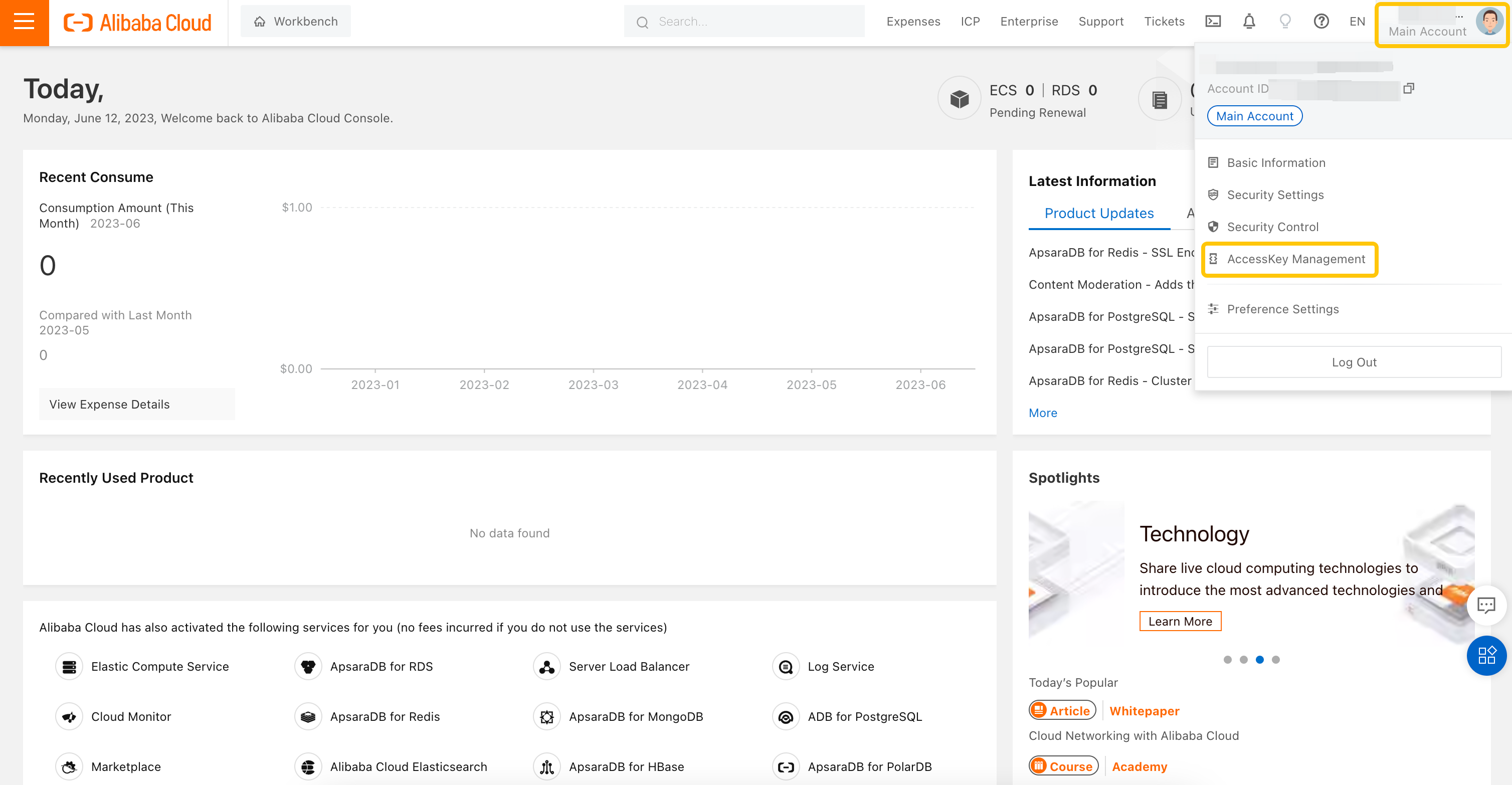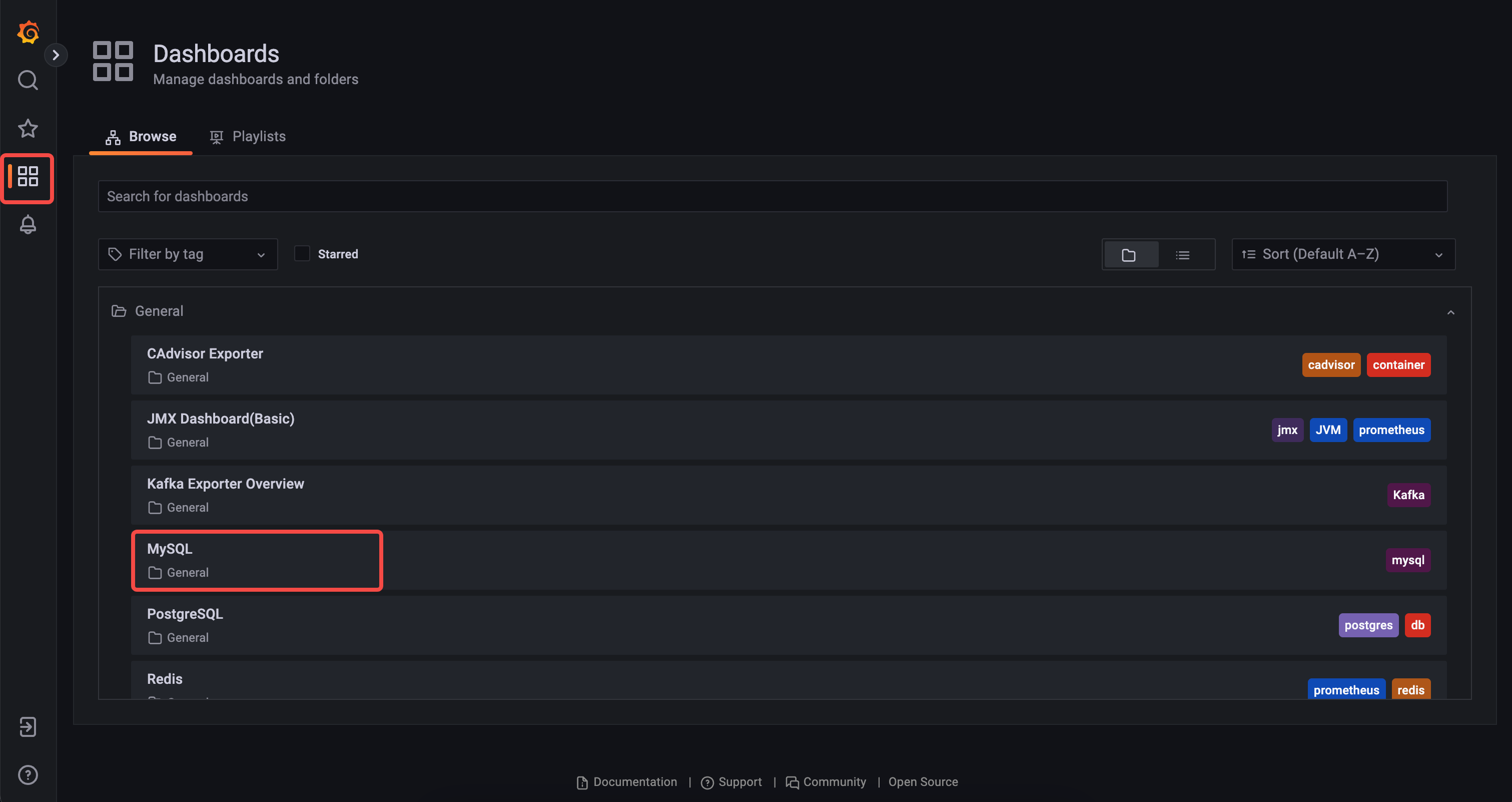Try out KubeBlocks on Cloud
This guide walks you through the quickest way to get started with KubeBlocks on cloud, demonstrating how to create a demo environment (Playground) with one command.
Preparation
When deploying KubeBlocks on the cloud, cloud resources are initialized with the help of the terraform script. kbcli downloads the script and stores it locally, then calls the terraform commands to initialize a fully-managed Kubernetes cluster and deploy KubeBlocks on this cluster.
- AWS
- GCP
- Tencent Cloud
- Alibaba Cloud
Before you start to try KubeBlocks on AWS
Make sure you have all the followings prepared.
Configure access key
Option 1. Use aws configure.
Fill in an access key and run the command below to authenticate the requests.
aws configure
AWS Access Key ID [None]: YOUR_ACCESS_KEY_ID
AWS Secret Access Key [None]: YOUR_SECRET_ACCESS_KEY
You can refer to Quick configuration with aws configure for detailed information.
Option 2. Use environment variables.
export AWS_ACCESS_KEY_ID="YOUR_ACCESS_KEY_ID"
export AWS_SECRET_ACCESS_KEY="YOUR_SECRET_ACCESS_KEY"
Initialize Playground
kbcli playground init --cloud-provider aws --region us-west-2
cloud-providerspecifies the cloud provider.regionspecifies the region to deploy a Kubernetes cluster. You can find the region list on the official website.
During the initialization, kbcli clones the GitHub repository to the directory ~/.kbcli/playground, installs KubeBlocks, and creates a MySQL cluster. After executing the kbcli playground init command, kbcli automatically switches the current context of kubeconfig to the new Kubernetes cluster.
Run the command below to view the created cluster.
# View kbcli version
kbcli version
# View the cluster list
kbcli cluster list
The initialization lasts about 20 minutes. If the installation fails after a long time, please check your network.
Before you start to try KubeBlocks on GCP
Make sure you have all the followings prepared.
- Google Cloud account
- Install kubectl
- Install kbcli
Configure GCP environment
Steps:
-
Install Google Cloud SDK.
# macOS brew install
brew install --cask google-cloud-sdk
# windows
choco install gcloudsdk -
Initialize GCP.
gcloud init -
Log in to GCP.
gcloud auth application-default login -
Configure GOOGLE_PROJECT environment variables,
kbcli playgroundcreates GKE cluster in the project.export GOOGLE_PROJECT=<project-name>
Initialize Playground
The following command deploys a GKE service in the region us-central1 on GCP, and installs KubeBlocks.
kbcli playground init --cloud-provider gcp --region us-central1
cloud-providerspecifies the cloud provider.regionspecifies the region to deploy a Kubernetes cluster.
During the initialization, kbcli clones the GitHub repository to the directory ~/.kbcli/playground, installs KubeBlocks, and creates a MySQL cluster. After executing the kbcli playground init command, kbcli automatically switches the current context of kubeconfig to the new Kubernetes cluster.
Run the command below to view the created cluster.
# View kbcli version
kbcli version
# View the cluster list
kbcli cluster list
The initialization takes about 20 minutes. If the installation fails after a long time, please check your network.
Before you start to try KubeBlocks on Tencent Cloud
Make sure you have all the followings prepared.
- Tencent Cloud account
- Install kubectl
- Install kbcli
Configure TKE environment
Steps:
-
Log in to Tencent Cloud.
-
Go to Tencent Kubernetes Engine (TKE) to grant resource operation permission to your account before using the container service.
-
Go to API Console -> Access Key -> API Keys and click Create Key to create a pair of Secret ID and Secret Key.
-
Add the Secret ID and Secret Key to the environment variables.
export TENCENTCLOUD_SECRET_ID=YOUR_SECRET_ID
export TENCENTCLOUD_SECRET_KEY=YOUR_SECRET_KEY
Initialize Playground
The following command deploys a Kubernetes service in the region ap-chengdu on Tencent Cloud and installs KubeBlocks.
kbcli playground init --cloud-provider tencentcloud --region ap-chengdu
cloud-providerspecifies the cloud provider.regionspecifies the region to deploy a Kubernetes cluster.
During the initialization, kbcli clones the GitHub repository to the directory ~/.kbcli/playground, installs KubeBlocks, and creates a MySQL cluster. After executing the kbcli playground init command, kbcli automatically switches the current context of kubeconfig to the new Kubernetes cluster.
Run the command below to view the created cluster.
# View kbcli version
kbcli version
# View the cluster list
kbcli cluster list
The initialization takes about 20 minutes. If the installation fails after a long time, please check your network.
Before you start to try KubeBlocks on Alibaba Cloud
Make sure you have all the followings prepared.
- Alibaba Cloud account.
- Install kubectl
- Install kbcli
Configure ACK environment
Steps:
-
Log in to Alibaba Cloud.
-
Follow the instructions in Quick start for first-time users to check whether you have activated Alibaba Cloud Container Service for Kubernetes (ACK) and assigned roles.
noteFor users who deploy Alibaba Cloud in China Mainland, refer to the corresponding guide.
-
Click AliyunOOSLifecycleHook4CSRole and click Agree to Authorization to create an AliyunOOSLifecycleHook4CSRole role.
This operation grant permissions to access Operation Orchestration Service (OOS) and to access the resources in other cloud products since creating and managing a node pool is required for creating an ACK cluster.
Refer to Scale a node pool for details.
-
Create an AccessKey ID and the corresponding AccessKey secret.
-
Go to Alibaba Cloud Management Console. Hover the pointer over your account console and click AccessKey Management.

-
Click Create AccessKey to create the AccessKey ID and the corresponding AccessKey secret.
-
Add the AccessKey ID and AccessKey secret to the environment variable to configure identity authorization information.
export ALICLOUD_ACCESS_KEY="YOUR_ACCESS_KEY"
export ALICLOUD_SECRET_KEY="YOUR_SECRET_KEY"
noteRefer to Create an AccessKey pair for details.
-
Initialize Playground
The following command deploys an ACK cluster in the region cn-hangzhou on Alibaba Cloud, and installs KubeBlocks.
kbcli playground init --cloud-provider alicloud --region cn-hangzhou
cloud-providerspecifies the cloud provider.regionspecifies the region to deploy a Kubernetes cluster.
During the initialization, kbcli clones the GitHub repository to the directory ~/.kbcli/playground, installs KubeBlocks, and creates a MySQL cluster. After executing the kbcli playground init command, kbcli automatically switches the current context of kubeconfig to the new Kubernetes cluster.
Run the command below to view the created cluster.
# View kbcli version
kbcli version
# View the cluster list
kbcli cluster list
The initialization takes about 20 minutes. If the installation fails after a long time, please check your network.
Try KubeBlocks with Playground
Go through the following instructions to try basic features of KubeBlocks.
Describe a MySQL cluster
Steps:
-
View the database cluster list.
kbcli cluster list -
View the details of a specified database cluster, such as
STATUS,Endpoints,Topology,Images, andEvents.kbcli cluster describe mycluster
Access a MySQL cluster
Option 1. Connect database from container network.
Wait until the status of this cluster is Running, then run kbcli cluster connect to access a specified database cluster. For example,
kbcli cluster connect mycluster
Option 2. Connect database remotely.
Steps:
-
Get Credentials.
kbcli cluster connect --show-example --client=cli mycluster -
Run
port-forward.kubectl port-forward service/mycluster-mysql 3306:3306
>
Forwarding from 127.0.0.1:3306 -> 3306
Forwarding from [::1]:3306 -> 3306 -
Open another terminal tab to connect the database cluster.
mysql -h 127.0.0.1 -P 3306 -u root -p"******"
>
...
Type 'help;' or '\h' for help. Type '\c' to clear the current input statement.
mysql> show databases;
>
+--------------------+
| Database |
+--------------------+
| information_schema |
| mydb |
| mysql |
| performance_schema |
| sys |
+--------------------+
5 rows in set (0.02 sec)
Observe a MySQL cluster
KubeBlocks has complete observability capabilities. This section demonstrates the monitoring function of KubeBlocks.
Steps:
-
Open the grafana dashboard.
kbcli dashboard open kubeblocks-grafanaResult
A monitoring page on Grafana website is loaded automatically after the command is executed.
-
Click the Dashboard icon on the left bar and two monitoring panels show on the page.

-
Click General -> MySQL to monitor the status of the MySQL cluster created by Playground.

High availability of MySQL
This guide shows a simple failure simulation to show you the failure recovery capability of MySQL.
Delete the Standalone MySQL cluster
Delete the Standalone MySQL cluster before trying out high availability.
kbcli cluster delete mycluster
Create a Raft MySQL cluster
You can use kbcli to create a Raft MySQL cluster. The following is an example of creating a Raft MySQL cluster with default configurations.
kbcli cluster create --cluster-definition='apecloud-mysql' --set replicas=3
Simulate leader pod failure recovery
In this example, delete the leader pod to simulate a failure.
Steps:
-
Make sure the newly created cluster is
Running.kbcli cluster list -
Find the leader pod name in
Topology. In this example, the leader pod's name is maple05-mysql-1.kbcli cluster describe maple05
>
Name: maple05 Created Time: Jan 27,2023 17:33 UTC+0800
NAMESPACE CLUSTER-DEFINITION VERSION STATUS TERMINATION-POLICY
default apecloud-mysql ac-mysql-8.0.30 Running WipeOut
Endpoints:
COMPONENT MODE INTERNAL EXTERNAL
mysql ReadWrite 10.43.29.51:3306 <none>
Topology:
COMPONENT INSTANCE ROLE STATUS AZ NODE CREATED-TIME
mysql maple05-mysql-1 leader Running <none> k3d-kubeblocks-playground-server-0/172.20.0.3 Jan 30,2023 17:33 UTC+0800
mysql maple05-mysql-2 follower Running <none> k3d-kubeblocks-playground-server-0/172.20.0.3 Jan 30,2023 17:33 UTC+0800
mysql maple05-mysql-0 follower Running <none> k3d-kubeblocks-playground-server-0/172.20.0.3 Jan 30,2023 17:33 UTC+0800
Resources Allocation:
COMPONENT DEDICATED CPU(REQUEST/LIMIT) MEMORY(REQUEST/LIMIT) STORAGE-SIZE STORAGE-CLASS
mysql false <none> <none> <none> <none>
Images:
COMPONENT TYPE IMAGE
mysql mysql docker.io/apecloud/wesql-server:8.0.30-5.alpha2.20230105.gd6b8719
Events(last 5 warnings, see more:kbcli cluster list-events -n default mycluster):
TIME TYPE REASON OBJECT MESSAGE -
Delete the leader pod.
kubectl delete pod maple05-mysql-1
>
pod "maple05-mysql-1" deleted -
Connect to the Raft MySQL cluster. It can be accessed within seconds.
kbcli cluster connect maple05
>
Connect to instance maple05-mysql-2: out of maple05-mysql-2(leader), maple05-mysql-1(follower), maple05-mysql-0(follower)
Welcome to the MySQL monitor. Commands end with ; or \g.
Your MySQL connection id is 33
Server version: 8.0.30 WeSQL Server - GPL, Release 5, Revision d6b8719
Copyright (c) 2000, 2022, Oracle and/or its affiliates.
Oracle is a registered trademark of Oracle Corporation and/or its
affiliates. Other names may be trademarks of their respective
owners.
Type 'help;' or '\h' for help. Type '\c' to clear the current input statement.
mysql>
Destroy Playground
-
Before destroying Playground, it is recommended to delete the database clusters created by KubeBlocks.
# View all clusters
kbcli cluster list -A
# Delete a cluster
# A double-check is required or you can add --auto-approve to skip it
kbcli cluster delete <name>
# Uninstall KubeBlocks
# A double-check is required or you can add --auto-approve to skip it
kbcli kubeblocks uninstall --remove-pvcs --remove-pvs -
Destroy Playground.
kbcli playground destroy
kbcli playground destroy deletes the Kubernetes cluster on the cloud, but there might be residual resources on the cloud, such as volumes and snapshots. Please delete them in time to avoid unexpected costs.